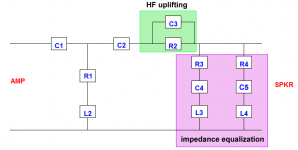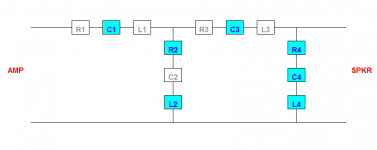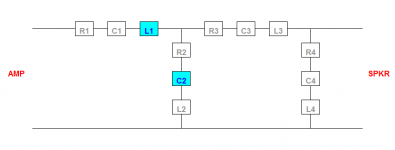Hi Everyone,
With regard to Jean-Michel's comment, would it be sufficient to be able to specify a passive filter in accordance with the attached network template, with only those components actually required being included?
If so, then a real time 'Filter Wizard' could be quite a nice thing to have....
R = resistor, C =capacitor, L = inductor.
Kind regards,
David
Seems to me that the matrix system shown by sabblebacke would be the most useful.
And as you proposed David it could be configured in just about any manner deemed necessary.
And a wizard section!
Oh my goodness gracious me!
It's not going to happen !
Maybe it is now
@ David McBean
Jmmlc was the member i was referring to in my earlier post, with regard to someone assisting you to impliment a HPF in HR. As he did with the "Impulse Response" module and the "Spectrogram" module
Which is what i, & others have been saying My hope for including one, was to allieviate excursion issues. Without a HPF the results are not Real World realistic, in that respect !
My hope for including one, was to allieviate excursion issues. Without a HPF the results are not Real World realistic, in that respect !
Indeed
I'm not against having other types of filter included, & compensation components etc. But the first & MOST important filter to include is a HPF. In a real system, especially sound systems, & increasingly these days home systems too, we use Active HPF's to protect our drivers. I'm not sure how you could code an Active HPF into HR though, as there would need to be a Virtual High Power Amplifier inbetween the HPF & Driver/s !
So i "guess" it'll have to be a High Power Passive, in some cases kW's ! You could have 2 options, a Low Power HPF that would model the components quite accurately, including losses . A second one that would be Lossless, to simulate an Active Filter before the Amp, which wouldn't effect the response etc as a Passive Filter with actual component losses would.
If whatever Filter/s you are able to include, could be variable via a slider/s =

Thanks for considering the option As i said before, it WILL make a Huge difference, & bridge the gap between Virtual & Real ! An important factor that has been missing !
As i said before, it WILL make a Huge difference, & bridge the gap between Virtual & Real ! An important factor that has been missing !
Regards
Maybe it is now
@ David McBean
Jmmlc was the member i was referring to in my earlier post, with regard to someone assisting you to impliment a HPF in HR. As he did with the "Impulse Response" module and the "Spectrogram" module
Originally Posted by David McBean
then a real time 'Filter Wizard' could be quite a nice thing to have...
Which is what i, & others have been saying
Originally Posted by Jmmlc
If we limit the choice to a high pass filter
Indeed
I'm not against having other types of filter included, & compensation components etc. But the first & MOST important filter to include is a HPF. In a real system, especially sound systems, & increasingly these days home systems too, we use Active HPF's to protect our drivers. I'm not sure how you could code an Active HPF into HR though, as there would need to be a Virtual High Power Amplifier inbetween the HPF & Driver/s !
So i "guess" it'll have to be a High Power Passive, in some cases kW's ! You could have 2 options, a Low Power HPF that would model the components quite accurately, including losses . A second one that would be Lossless, to simulate an Active Filter before the Amp, which wouldn't effect the response etc as a Passive Filter with actual component losses would.
If whatever Filter/s you are able to include, could be variable via a slider/s =
Thanks for considering the option
Regards
In fact, this is rather simple, since the input-impedance doesn´t get in your way. All that had to be done ist to do the calculus on the input signal, there will be no reaction on the speakers impedance when dealing with active-filtering prior the amp.I'm not sure how you could code an Active HPF into HR though, as there would need to be a Virtual High Power Amplifier inbetween the HPF & Driver/s !
But of course, there is more to implementing such a functionality than to look up Butterworth filter - Wikipedia, the free encyclopedia and put some equations in
Thanx to david for even thinking about putting something like this in.
Maybe if the impedance could be ignored in favour of a fixed resistanceI'm not sure how you could code an Active HPF into HR though, as there would need to be a Virtual High Power Amplifier inbetween the HPF & Driver/s !
it would be great the have a hpf included in hr.
tnx david(again)
My vote would be to work on implementing an active HPF first, because, let's face it, I think most of us use HornResp to model bass horns, and most of us do so with the intent of using an active HPF at or before the amp to modify the response at the low end and to protect the driver from over-excursion.
These active HPFs can be described in three simple terms:
1. Order (1st, 2nd, etc. - I think most are 2nd or above, as 1st order does not provide enough attenuation for the purpose intended)
2. Crossover Frequency (self-explanatory)
3. "Q" (Butterworth=0.7, LR=0.5, etc.).
Perhaps this could be implemented in HornResp by adding an additional option called "Source" in the LoudSpeaker Wizard's second pull-down menu, and placing "Eg" and the above as adjustable parameters under this selection.
My vote would be to work on implementing an active HPF first, because, let's face it, I think most of us use HornResp to model bass horns, and most of us do so with the intent of using an active HPF at or before the amp to modify the response at the low end and to protect the driver from over-excursion.
These active HPFs can be described in three simple terms:
1. Order (1st, 2nd, etc. - I think most are 2nd or above, as 1st order does not provide enough attenuation for the purpose intended)
2. Crossover Frequency (self-explanatory)
3. "Q" (Butterworth=0.7, LR=0.5, etc.).
Perhaps this could be implemented in HornResp by adding an additional option called "Source" in the LoudSpeaker Wizard's second pull-down menu, and placing "Eg" and the above as adjustable parameters under this selection.
I strongly agree with all this. I don't see any need for passive filters or low pass filters. (That's not to say it wouldn't be nice to have them but by far the most important thing is active high pass filters.) Not that it really matters though, I use Akabak for this, but it would save some time to be able to do it in Hornresp.
I'll thrown in my 

The idea of passive filters is an interesting one. We have always had the option to export the impulse, and from there you can do all manner of acoustic filter "stuff" externally.
For me the need is for physical performance with active HPF, passive would also be nice. Being able to see what happens with excursion at the bottom of the pass band would be of HUGE benefit, and you can't get that working from an impulse.

The idea of passive filters is an interesting one. We have always had the option to export the impulse, and from there you can do all manner of acoustic filter "stuff" externally.
For me the need is for physical performance with active HPF, passive would also be nice. Being able to see what happens with excursion at the bottom of the pass band would be of HUGE benefit, and you can't get that working from an impulse.
I'll thrown in my
The idea of passive filters is an interesting one. We have always had the option to export the impulse, and from there you can do all manner of acoustic filter "stuff" externally.
For me the need is for physical performance with active HPF, passive would also be nice. Being able to see what happens with excursion at the bottom of the pass band would be of HUGE benefit, and you can't get that working from an impulse.
Hello,
I think both active and passive filtres are interesting to be introduced in Hornresp, but that's double work.
We can say that the active filter approach relates to Eg in the Hornresp input data window, while the passive filter approach relates to Rg.
Best regars from Paris, France
Jean-Michel Le Cléac'h
Not necessarily. The calculations can be almost the same, the active part can simply be fed to a constant impedance instead of the changing one on a real speaker.Hello,
I think both active and passive filtres are interesting to be introduced in Hornresp, but that's double work.
How about implenenting a plugin interface at Rg and Re, so every filter one desires can be flunged in there, let´s build some VST Interface, this way David doesn´t have to do the filterstuff himself an we can even implement FIR Filtering (hihi, just playing with my mind, just kidding).
If we limit the choice to a high pass filter, with a few more components than in your schematics we can also provide impedance equalization and HF uplifting.
(I put 2 RLC impedance equalizors but one could eventually be enough, even if with horns there is often more than 2 peaks of impedance).
Hi Jean-Michel,
Thanks for the feedback.
If I understand correctly, the two HF uplift components are the only ones missing from my template (if we assume that only one RLC impedance equaliser is required).
Would the template still be worth having even if HF uplifting was not allowed for?
Kind regards,
David
Attachments
I´d even go either for the simple solution of just having some High-Pass Filtering and just stick with that - or go all the way and do the matrix thing, so all cases are covered. In Jean-Michels Example, you have:
- Two Impedance eq for the lower and upper end
- HF uplifting
- Highpass uo to 3. Order
Notch Filters, Lowpass, Allpass, etc.. - are still missing.
Of course, one could argue that you don´t need those a lot - but I bet there are people who will be asking for it (e.g. someone who wants to get rid of a resonance in a mid-Horn System and either wants to use a helmholtz resonator as a mechnical solution or do it in the x-over...)... So people will ask for extensions of the limited model and maybe its less work to do the flexible soultion in the first place ?
- Two Impedance eq for the lower and upper end
- HF uplifting
- Highpass uo to 3. Order
Notch Filters, Lowpass, Allpass, etc.. - are still missing.
Of course, one could argue that you don´t need those a lot - but I bet there are people who will be asking for it (e.g. someone who wants to get rid of a resonance in a mid-Horn System and either wants to use a helmholtz resonator as a mechnical solution or do it in the x-over...)... So people will ask for extensions of the limited model and maybe its less work to do the flexible soultion in the first place ?
Hi Everyone,
Thanks for all your filter comments. If anything was to be done in Hornresp, the functionality would be confined to passive filters comprised of pure resistors, capacitors and inductors, and most probably be restricted to networks that can be specified within the 12 component template previously posted.
So don't get too excited... .
.
Kind regards,
David
Thanks for all your filter comments. If anything was to be done in Hornresp, the functionality would be confined to passive filters comprised of pure resistors, capacitors and inductors, and most probably be restricted to networks that can be specified within the 12 component template previously posted.
So don't get too excited...
Kind regards,
David
Hi Jean-Michel,
Thanks for the feedback.
If I understand correctly, the two HF uplift components are the only ones missing from my template (if we assume that only one RLC impedance equaliser is required).
Would the template still be worth having even if HF uplifting was not allowed for?
Kind regards,
David
Hello David,
Your template will be definitevely worth.
Eventually for every RLC circuit a wizzard could be opened at demand in order to introduce the resonance frequency and Q...
Circuit Theory/RLC Circuits - Wikibooks, open books for an open world
Best regards from Paris, France
Jean-Michel Le Cléac'h
Notch Filters, Lowpass, Allpass, etc.. - are still missing.
Hi Sabbelbacke,
I must be missing something - isn't the two-component network shown in the attachment a simple low pass filter?
It can be specified using the previously mentioned template.
Kind regards,
David
Attachments
Your template will be definitevely worth.
Eventually for every RLC circuit a wizzard could be opened at demand in order to introduce the resonance frequency and Q...
Hi Jean-Michel,
Thanks for confirming that the 12 component template would still be of some value.
The filter tool would show the SPL response and the diaphragm displacement resulting from having a filter network between the amplifier output and the loudspeaker input. The tool would accept R, C and L component values as specified by the user, but not deal with resonance frequency and Q values.
Kind regards,
David
- Home
- Loudspeakers
- Subwoofers
- Hornresp


